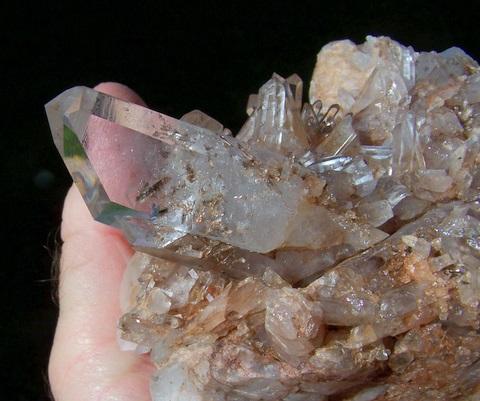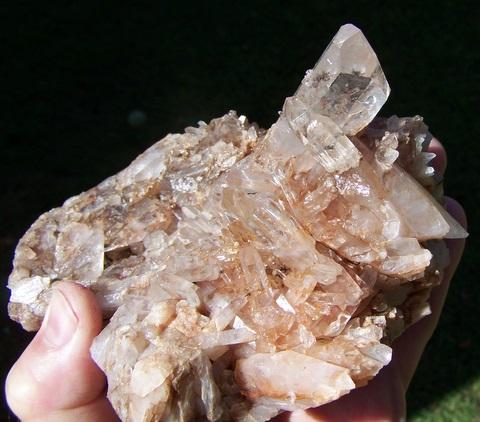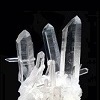| View previous topic :: View next topic |
| Author |
Message |
Pierre Joubert
Joined: 09 Mar 2012
Posts: 1605
Location: Western Cape



|
 Posted: Apr 29, 2012 05:23 Post subject: Repairing mineral specimens Posted: Apr 29, 2012 05:23 Post subject: Repairing mineral specimens |
|
|
Repairing mineral specimens has always been a difficult topic to me. I understand that some of the most famous specimens have been repaired, to put it in more simple terms, 'glued'. Some time ago, a dealer gave me a handful of nice crystals with a few flaws. He said with disgust that they were glued! I studied them and after some acid tests, found that he was wrong and that they were not glued. His reaction to what he thought were repaired specimens is the point.
If a specimen is repaired then I would expect the seller of such a specimen to reveal that fact to the buyer, but the problem comes when it is sold again and the next seller conveniently chooses to not reveal this fact to the next buyer.
While on this topic, I have attached some photos of a Quartz specimen that my wife found in our nearby mountains. You will note that the matrix is sandstone and that the crystals sit on a cracked and unstable matrix. What 'glue' can be used to stabilize the fragile matrix. I would welcome some thoughts on this topic.
| Description: |
Quartz crystals on Sandstone
Western Cape Mountains
150 x 85 mm |
|
| Viewed: |
41475 Time(s) |

|
| Description: |
Quartz crystals on Sandstone
Western Cape mountains
150 x 85 mm |
|
| Viewed: |
41523 Time(s) |

|
_________________
Pierre Joubert
'The tree of silence bears the fruit of peace. ' |
|
| Back to top |
|
 |
lluis
Joined: 17 Nov 2006
Posts: 719


|
 Posted: Apr 29, 2012 08:21 Post subject: Re: Repairing mineral specimens Posted: Apr 29, 2012 08:21 Post subject: Re: Repairing mineral specimens |
|
|
Goiemor, Pierre
Well, for one side, acid test have nothing to do with glued or not. Glues in general are acid resistants. Some are not water resistants, and others are non resistant to some specific solvents. Or specific solvents at a temperature.
For the specimen, I see it as stable and I could not see the sandstone matrix.
But if you wish to stibilize it more, I would use a glue sensible to UV, place in the weaker points in a twilight ilumination (or in a room with only incandescent light; no fluorecents!) the glue, wipp off what is undesired, and then let it in sunglight.
That would be stabilized, and if I do not remember bad, could be undone placing the piece in perchloroethylene in a sealed jar for some time (some days; or weeks...). Always if you use a cyanacrylate. If a polyester, well, just caustic soda and crossing fingers....And then not even sure....
(those glues are not acidic sensitive, as an example)
With best wishes (my afrikaans goes not too far from the good morning... :-( )
Lluís
|
|
| Back to top |
|
 |
alfredo
Site Admin

Joined: 30 Jan 2008
Posts: 1014



|
 Posted: Apr 29, 2012 08:40 Post subject: Re: Repairing mineral specimens Posted: Apr 29, 2012 08:40 Post subject: Re: Repairing mineral specimens |
|
|
In my opinion a large segment of our mineral collecting fraternity makes too great an issue about repairs. In many collecting fields (fossils, antiquities,...) repairs are expected and only a minority of specimens are not repaired.
Micromounters don't have to worry much about repairs, but the bigger the size of specimen, the less likely it is to come out of the ground undamaged. If one absolutely insists on no damage and no repairs on cabinet-size specimens, I say don't complain about the extra zero (or two) on the price!
I have only two absolute requirements about repairs: 1) they should be expertly done so as not to be glaringly obvious; and 2) they must be revealed to the customer.
|
|
| Back to top |
|
 |
John S. White
Site Admin

Joined: 04 Sep 2006
Posts: 1298
Location: Stewartstown, Pennsylvania, USA



|
 Posted: Apr 29, 2012 09:00 Post subject: Re: Repairing mineral specimens Posted: Apr 29, 2012 09:00 Post subject: Re: Repairing mineral specimens |
|
|
I would quibble with Alfredo over the comment that a majority of specimens are repaired. I would say that a very small minority of specimens have been reapaired.
_________________
John S. White
aka Rondinaire |
|
| Back to top |
|
 |
Tobi
Site Admin

Joined: 07 Apr 2009
Posts: 4251
Location: Germany



|
 Posted: Apr 29, 2012 09:01 Post subject: Re: Repairing mineral specimens Posted: Apr 29, 2012 09:01 Post subject: Re: Repairing mineral specimens |
|
|
| alfredo wrote: | | I have only two absolute requirements about repairs: 1) they should be expertly done so as not to be glaringly obvious; and 2) they must be revealed to the customer. |
I agree, Alfredo mentioned the two most important and essential conditions concerning repairs.
|
|
| Back to top |
|
 |
Joseph DOliveira

Joined: 29 Jan 2012
Posts: 311
Location: Hanmer, Ontario



|
 Posted: Apr 29, 2012 09:19 Post subject: Re: Repairing mineral specimens Posted: Apr 29, 2012 09:19 Post subject: Re: Repairing mineral specimens |
|
|
While I don't agree with the statement "the majority of specimens are repaired", there are some specimens where the majority from a particular occurrence are repaired. A good example of these are the pyrite cubes from Spain, and the larger tourmaline specimens from Pala, many of which are repaired but still carry good value. From a dealers perspective, disclosure of repair is essential and for the most part is accepted by collectors as the specimens generally carry a discounted value.
_________________
Joseph D'Oliveira
Hanmer, Ontario
Canada |
|
| Back to top |
|
 |
lluis
Joined: 17 Nov 2006
Posts: 719


|
 Posted: Apr 29, 2012 09:25 Post subject: Re: Repairing mineral specimens Posted: Apr 29, 2012 09:25 Post subject: Re: Repairing mineral specimens |
|
|
Good afternoon
Well, I beg to difer with Alfredo in antiquities.
Not many are repaired (well, if you discount the composites mainly in chinese old pieces, as far as I know), many are damaged and a few are intact.
And well, I for one, I prefer an undamaged one, or, if I should choose, a damaged one *unrepaired*
For minerals, well, I collect in the small size, miniature to TN, mainly....
Then, I am out of the museum size league and away from reparations as well.
I agree with Alfredo that repairs should be expertly done and disclosed to buyers.
But I dislike repairs....Say me odd
With best wishes
Lluís
|
|
| Back to top |
|
 |
Pierre Joubert
Joined: 09 Mar 2012
Posts: 1605
Location: Western Cape



|
 Posted: Apr 29, 2012 11:21 Post subject: Re: Repairing mineral specimens Posted: Apr 29, 2012 11:21 Post subject: Re: Repairing mineral specimens |
|
|
| lluis wrote: | Goiemor, Pierre
Well, for one side, acid test have nothing to do with glued or not. Glues in general are acid resistants. Some are not water resistants, and others are non resistant to some specific solvents. Or specific solvents at a temperature.
For the specimen, I see it as stable and I could not see the sandstone matrix.
But if you wish to stibilize it more, I would use a glue sensible to UV, place in the weaker points in a twilight ilumination (or in a room with only incandescent light; no fluorecents!) the glue, wipp off what is undesired, and then let it in sunglight.
That would be stabilized, and if I do not remember bad, could be undone placing the piece in perchloroethylene in a sealed jar for some time (some days; or weeks...). Always if you use a cyanacrylate. If a polyester, well, just caustic soda and crossing fingers....And then not even sure....
(those glues are not acidic sensitive, as an example)
With best wishes (my afrikaans goes not too far from the good morning... :-( )
Lluís |
Lluis, thanks for the bit of Afrikaans and advice. I am sorry, the sandstone is not very visible; but the cracks are. I know acetone dissolve some glues, eg. clear epoxy. The best would be a type of thin/transparent glue that can 'lock' the very fragile/unstable sandstone. What about 'superglue'?
_________________
Pierre Joubert
'The tree of silence bears the fruit of peace. ' |
|
| Back to top |
|
 |
Jesse Fisher

Joined: 18 Mar 2009
Posts: 639
Location: San Francisco



|
 Posted: Apr 29, 2012 11:59 Post subject: Re: Repairing mineral specimens Posted: Apr 29, 2012 11:59 Post subject: Re: Repairing mineral specimens |
|
|
| "Super Glue" is a trade name for cyanoactrylate. It generally works quite well for stabilizing porous and crumbly matrices on specimens as it is fairly thin and will penetrate quite well. Make sure the specimen is completely dry as it does not work well in the presence of water. Also, avoid any glues that are labeled "gel" as these have been thickened and will not penetrate as well.
|
|
| Back to top |
|
 |
lluis
Joined: 17 Nov 2006
Posts: 719


|
 Posted: Apr 29, 2012 12:47 Post subject: Re: Repairing mineral specimens Posted: Apr 29, 2012 12:47 Post subject: Re: Repairing mineral specimens |
|
|
Hi, Pierre
Agreed with Jesse.
Cyanacrylate is the chemical name for superglue (or crazy glue... :-) ); just that some only cure under UV, so, they let you more time to work, and uses to be less stressing.... :-)
Also, done that uses to be used to repair glass, RI uses to be closer to it and generally less visible.
But that is just manias of an old chemist... :-)
With best wishes
Lluís
|
|
| Back to top |
|
 |
Pierre Joubert
Joined: 09 Mar 2012
Posts: 1605
Location: Western Cape



|
 Posted: Apr 29, 2012 13:01 Post subject: Re: Repairing mineral specimens Posted: Apr 29, 2012 13:01 Post subject: Re: Repairing mineral specimens |
|
|
Also, done that uses to be used to repair glass, RI uses to be closer to it and generally less visible.
Thanks Lluis. What do you mean by RI? Is it a type of superglue? Groete
_________________
Pierre Joubert
'The tree of silence bears the fruit of peace. ' |
|
| Back to top |
|
 |
Jesse Fisher

Joined: 18 Mar 2009
Posts: 639
Location: San Francisco



|
 Posted: Apr 29, 2012 14:35 Post subject: Re: Repairing mineral specimens Posted: Apr 29, 2012 14:35 Post subject: Re: Repairing mineral specimens |
|
|
| "RI" means "refractive index," which is the degree that a transparent substance will bend (refract) light compared to air. If two transparent substances have a large difference between their refractive indices the boundary between them will be more visible than if the refractive indices are close to one another. When gluing a transparent mineral, or filling fractures with glue or resin, it is always best to use something with an RI close to the mineral so that it will be less noticeable. Opticon is a commercial resin that has an RI very close to quartz and has been used for repairs and fracture filling on many mineral specimens. The one draw-back to Opticon is that it will turn yellow with age and is quite difficult to remove once it is hardened.
|
|
| Back to top |
|
 |
Jordi Fabre
Overall coordinator of the Forum

Joined: 07 Aug 2006
Posts: 5094
Location: Barcelona



|
 Posted: Apr 29, 2012 15:35 Post subject: Re: Repairing mineral specimens Posted: Apr 29, 2012 15:35 Post subject: Re: Repairing mineral specimens |
|
|
| alfredo wrote: | In my opinion a large segment of our mineral collecting fraternity makes too great an issue about repairs...
|
What Alfredo say it could be true but we should live with the fact that while in USA the repaired specimens are more or less accepted, for some reason the vast majority of the regular collectors in Europe don´t accept repaired specimens. This inevitable fact generate in my oppinion a lot of paradoxes like for example: what about a specimen offered by a reliable and serious US dealer but that he acquired to someone, and as that dealer don't take a really strong care about the repaired specimens he don't check it with acetone (for example) and he offer to an European customer who don't really accept repaired specimens but unluckily this particular specimen was repaired and (without bad behaviour from the dealer) is not labeled as "repaired"?
And how about a lot of fresh specimens just arrived from a mining area, all of them looking "natural" but as we never know, and just on case, we submerged them in acetone and time to time (or frequently, if from some particular places ;-) we discover some fascinating "surprises"? ;-)
So if the door for repaired specimens remain a little bit open because we don't should "makes too great an issue about repairs", we haven't the risk to facilitate in some way dishonest "crafts" from the primary sources or some private sellers?
|
|
| Back to top |
|
 |
lluis
Joined: 17 Nov 2006
Posts: 719


|
 Posted: Apr 29, 2012 15:53 Post subject: Re: Repairing mineral specimens Posted: Apr 29, 2012 15:53 Post subject: Re: Repairing mineral specimens |
|
|
Goeienag, Pierre
As Jesse says, RI is refractive index.
I thought that Opticon is for emeralds, though...
Anyway, superglue, as far as I know does not turns yellow (even less the one used for crystal repair), and is removable (with time) with chlorinated solvents.
Groete
Lluís
|
|
| Back to top |
|
 |
lluis
Joined: 17 Nov 2006
Posts: 719


|
 Posted: Apr 29, 2012 16:01 Post subject: Re: Repairing mineral specimens Posted: Apr 29, 2012 16:01 Post subject: Re: Repairing mineral specimens |
|
|
Completely agreed with Jordi
Some specimens that have beeng air eroded, consolidated, dyed, and so, well, for me are just, maybe, a work of art. But not a mineral specimen.
I know that Alma King have been glued (or so I have been said), and it took a lot of time (a year?) to repair it. Nice. Even interesting. But *repaired*.
Maybe too european in the Jordi sense, but I could not close eyes in front of it.
The rest is to open the field to man-made paragenesis.
Is like the rocketing in acceptance of tooled ancient coins.
Well, hobbo nickels sometimes are more artistic.
Needless to say that a tooled ancient coin, apart to be impossible to authenticate, is for me just a modern anything (place the word you beleive I am thinking in....)
With best wishes
Lluís
|
|
| Back to top |
|
 |
|





